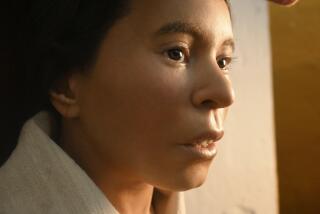Chinese mummies bring surprises to surface
Industrial development in northwest China has gradually unearthed a surprising past -- a 4,000-year-old civilization of farmers and herders with European, rather than Asian, ancestry.
These ancient people eked out a living in the arid lands north of Tibet now known as the Tarim Basin.
Chinese construction crews have found mummies nearly every year over the last three decades. Three of the mummies will be on view at Santa Ana’s Bowers Museum as part of the exhibition “Secrets of the Silk Road: Mystery Mummies from China,” which opens Saturday.
Victor H. Mair, a professor of Chinese language and literature at the University of Pennsylvania, has been studying the mummies and their culture since the early 1990s, and he edited the catalog for the exhibition. He discussed their significance with The Times.
When were these mummies discovered?
European explorers in the early part of the 20th century noticed some of the mummies, but were not interested in them as worthy of research, so they respectfully reburied the human remains they encountered. As is true with the vast majority of archaeological discoveries elsewhere in China since the founding of the People’s Republic, most of the mummies were unearthed in the course of construction projects that have taken place since the late ‘70s.
Do they look Chinese?
The earliest mummies all have a Europoid or Caucasoid appearance, with blond, reddish and light-blond hair. This is largely true from around 2000 BC down to about the 4th to 5th century AD.
What happened to them?
After that, the mummies soon take on an increasingly Mongoloid appearance, with increasingly darker hair. By around 1000 AD, the Europoid/Caucasoid peoples had been largely displaced or absorbed by peoples coming from the east.
Why are they in such good condition?
The main reason is the special environment of the region. It is extremely dry, very hot in summer, very cold in winter, and many parts of the region have extraordinarily saline soils. All of these factors together prevented putrefaction and promoted desiccation.
There was minimal preparation for burial. In some cases, a substance containing animal proteins was smeared on the bodies. Great care was taken to keep the deceased from touching the ground, as this would tend to lead to deterioration of the flesh. But there was nothing artificial, such as treatment with chemicals or removal of the brain and innards, that was done to the Egyptian mummies.
The exhibition features a 3,800-year-old mummy known as “the Beauty of Xiaohe.” What’s so special about her?
She is, quite simply, the most beautiful mummy from Eastern Central Asia. She has long eyelashes, perfect facial features, smooth skin, and is wearing a jaunty hat. I call her the Marlene Dietrich of the desert.
How were the mummies studied?
A thorough physical examination would be something like an autopsy, but so far the examination of all but one of the mummies has been extremely cursory. One of the mummies, called “the Beauty of Loulan,” was examined for body lice, soot and silica in her lungs, and other rather superficial or simple conditions. [She is not part of the exhibition.]
There is so much more that should be done to understand better how the mummy people lived and died. The contents of their stomach and intestines should be examined, analysis of the isotopes in their hair should be done, bone anomalies should be described carefully, and so forth. That would tell us how the mummies lived and died, what their health was like, what illnesses they contracted, what they consumed, and even where they were from.
What artifacts were found with the mummies?
Finely woven wool mantles that also functioned as blankets and, in death, shrouds. Wooden statues (some wearing clothing), model phalluses, bracelets, baskets and so forth. Bronze implements are also evident.
What was the significance of these items?
They each have their own meaning. It would take me a small book to explain all of them.
Were the phalluses unusual?
Yes, indeed!
What is their meaning?
The people placed high emphasis on procreation.
What else can you infer about their lives based on how they were laid to rest?
They were agropastoralists who were good at raising cattle and sheep and who were able to utilize the minimal available water for growing wheat.
Have the mummies prompted scientists to rethink their ideas about life during the Bronze Age and Early Iron Age?
We have a far better understanding of the development of Eurasian civilization than we did before, including the movements of people and the technologies and culture associated with them. For example, wheat, sheep and goats, wheeled vehicles, and bronze metallurgy all came from the West, and the mummy people had all of these items before they appeared in East Asia. Their discovery has transformed our understanding of the late prehistory and early history of Eurasia.
“Secrets of the Silk Road: Mystery Mummies from China” includes three mummies and more than 150 artifacts. The exhibit will be on view at the Bowers Museum through July 25. For more information, visit www.bowers.org “> www.bowers.org .
More to Read
The biggest entertainment stories
Get our big stories about Hollywood, film, television, music, arts, culture and more right in your inbox as soon as they publish.
You may occasionally receive promotional content from the Los Angeles Times.











